Dear Artist,
Yesterday, Chris Bingle of Stroud in Gloucestershire, UK, asked about signing paintings. She recently turned down the purchase of one because the artist had signed her name “quite high on the lower left in a thick, black stylized script. It jolted the eye and brain,” she said. “I knew it would bother me.”
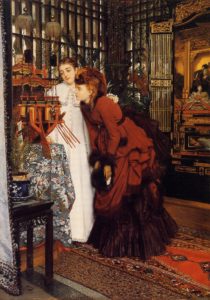
Young Ladies Looking at Japanese Objects, 1869
Oil on canvas
27.7 inches 19.7 inches
by Jacques Joseph Tissot (1836-1902)
Chris signs her own work “in a colour a few degrees darker than the background.” Simple and understated is Chris’s thinking. I agree. I like my name to be neat, legible and not too intrusive. It’s a personal preference, but I’m here to tell you there’s more to a signature than meets the eye. Like paintings themselves, they carry a meta-message about the artist.
Think of the range of signatures you know. They may give impressions of strength, weakness, haste, ignorance, naivety, stiffness, contrivance, carelessness, obscurity, egocentricity, humility, commercialism, etc. Just as handwriting experts speculate on the nature of the writer, viewers pick up information from a few innocuous letters and flourishes. Some artists, consciously or unconsciously, bring their signature into harmony with their work. If you look around, you’ll also see signature styles that are in contrast to the style of the work. Concerned with the toil of their personal process, they may sign cursorily to convey the impression of bravura. Painters with bravura, on the other hand, may sign neatly to magnify the contrast. I’ve noticed that the size of my signature fluctuates with the size of my current feelings of prowess. Signatures are a window to the machinations of personality.
Mysterious, cryptic and illegible signatures aside, many artists simply want to be known as fellow humans — folks with consistent first and last names and sometimes an initial or two. These days, whether a mouthful or a singular moniker, your name needs to be somewhat distinct for Internet purposes. Singular can be problematic. “Vincent,” for example, has been taken. In my case, I like them to know my first name as well as my last. When strangers call me “Robert,” I know they know my work. Everybody else calls me “Bob.” But then again, you are you, and your signature is part of your entity. It’s your life. Sign your life as you would live it.
Best regards,
Robert
PS: “Prince, you are you by accident of birth; what I am, I am of myself. There are and there will be thousands of princes. There is only one Beethoven.” (Ludwig van Beethoven)
Esoterica: Chris also wanted to know about the current fashion of not signing work at all. Or if at all — on the edge or the back. People look at these works with puzzlement and ask, “Who is this person who is unable to identify himself?” Actually, some artists feel good about doing this. It seems to me that front-signing is a simple, time-honoured convention worth caving in to. I like the company. Bending down with a small sable, I figure if Titian, Turner, Tissot and Toulouse-Lautrec did it, it’s gotta be okay.
This letter was originally published as “Signing your life away” on November 2, 2007.
Have you considered a Premium Artist Listing? With each letter, an artist is featured at the bottom of this page. The Premium Artist Listings are a means of connecting artist subscribers through their work. Proceeds from each listing contribute to the production of The Painter’s Keys.
“I’m able to sign my name to the paintings. That is really a blessing.” (Margaret Keane)
Featured Workshop
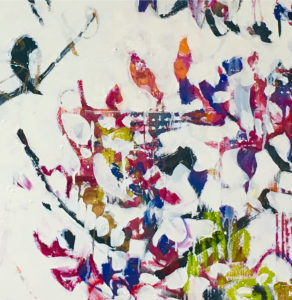 Join Ellie Harold for “Intuitive Painting: Permission to Paint Expressively,” designed especially for mature women artists of all skill levels who wish to explore this medium for soulful exploration. The retreat provides attractive accommodations (your own room!) along with lightly structured activities for centering, relaxation and low stress art-making. You’ll have plenty of free time to muse, paint, write and reflect while enjoying the colors, textures and flavors of San Miguel. This Retreat has the potential to transform not only your art but your life! You’ll return home with a specific art “care plan” to assure support for further creating. Details at www.EllieHarold.com.
Join Ellie Harold for “Intuitive Painting: Permission to Paint Expressively,” designed especially for mature women artists of all skill levels who wish to explore this medium for soulful exploration. The retreat provides attractive accommodations (your own room!) along with lightly structured activities for centering, relaxation and low stress art-making. You’ll have plenty of free time to muse, paint, write and reflect while enjoying the colors, textures and flavors of San Miguel. This Retreat has the potential to transform not only your art but your life! You’ll return home with a specific art “care plan” to assure support for further creating. Details at www.EllieHarold.com.
Featured Artist
The way that I interpret what I see
is my Way.
I paint, because it’s the most satisfying way that I’ve found
to be myself.
Fish swim.
Birds fly.
I paint.
Boldly.
On canvas,
with acrylics.

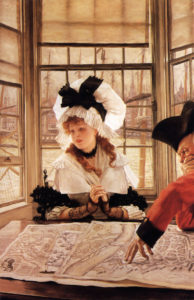
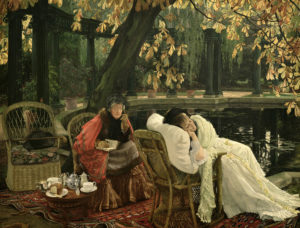
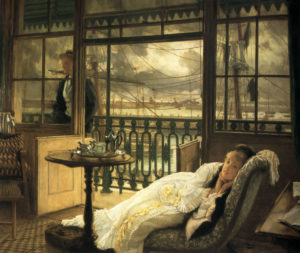
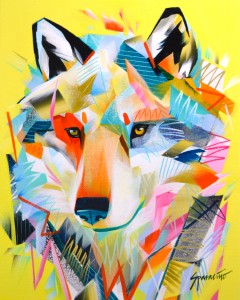



17 Comments
“ Sign your life as you would live it.”
Ah… yes… and there is only one Robert Genn
This is a ridiculous point , sign the damn work , it isn’t noble to do other than , or hide it . This thinking is backwards !
OK….I sign everything I make if possible….some things are too small, so I use a metal signature stamp….sometimes coupled with a copyright logo and a USA stamp….sometimes with first & last & materials & copyright & USA all on one piece!!!! Of course all this is on the backside of jewelry pieces….But even my wall pieces are signed on the backside….I don’t want a signature to interfere with the visual of the work. I knew a paper artists who created framed collages….her “signatures” were the most significant visual of her pieces….my opinion of this was negative. Sign it….it’s your maker’s mark. I have more of a problem with dating the work….and I usually don’t do that.
I always sign somewhere along the bottom, either side, so that it’s legible but unobtrusive. Easy enough to design in a spot for it in the grasses/water/tablecloth. If a really small piece I’ll use initials. Nowadays I use canvas glued to board, and also sign the back with my name and the title of the piece, using a Pigma micron pen. I should probably add the © symbol; I would not have bothered in the past, but then again I didn’t always feel the need to lock my car, at least where I live. *sigh*
I too also sign the back when possible. I have not been good about keeping a catalog of my pieces…
I have usually signed my work, on the front. The few times I haven’t it’s because the work is small and it would be intrusive. I then sign on the back.
A very good article on the subject:
https://www.artbusiness.com/signart.html
Not all works of Art are intended ‘For Sale’. Consider Mexican Retablo Art, which is highly emotional work and of great import to the artist, but usually not in any way intended for notoriety, or sale. They are expressing gratitude (to God, or a Saint) for a blessing or a miracle which greatly affected their lives. The work is more akin to prayer. They are rarely ever signed, or the artist simply uses their initials, or only their first name. In addition, there are works of Art which are intended as a heirloom for a family member, or friend … and again, not ‘for sale’.
Sometimes a signature is intrusive on the overall picture. Sometimes I sign on the back if the picture is on Masonite and sign it with a pencil. If I sign a canvas on the front in a bold color it is because it is used to help balance the color harmony, or not.
I sign my stuff (usually) and consider placement, color, size in harmony with the rest of it. I have adopted a self-imposed habit of using just a trademark initial for preliminary studies. I infuriated my parents when I went through a teenage phase of signing with an alias, thinking I would/might/could be oh so famous someday and could yet live anonymously. I also date my stuff, another exercise at the center of it’s own dust devil of aesthetic crisis. I do so after looking at years of my earlier sketchbooks and doodles that went undated and therefore unmoored in the sixty year sea of my work. Signing a finished piece is also my personal rule that I am done with it. No more fiddling, poking, or scrabbling is allowed unless a really offensive passage or omission got through the critical gauntlet.
I remember many years ago in my learning years at class, the instructor telling we females to not put our first name. I was advised that male artists were considered more valuable, so sales and promise of success would be helped by only putting my first name initial. This was so long ago, I thought that advise was okay. So I did that, and still do that to this day. Not because I feel that if someone thinks Mervin Laing did the painting, that makes it appear more worthy, because writing out Mary Ann Laing is too much work. I have a hard time printing/writing with a tiny brush, shorter and simpler the better.
Any signature on the front of my work no matter how small interferes with the painting. I’d like it to be on the front but it interferes with alot of abstract contemporary painting especially very detailed slightly minimal work. I finally decided to sign it on the back part of the canvas that wraps around the stretcher bar.
In my mind, the signature is part of the painting. It should be done in so it adds to the composition rather than interfere. It should be in harmony with the rest of the work. Often it can balance a composition, add a needed element.
Signing is an art in itself.
I am always disappointed when viewing a lovely painting with no signature. I have just inherited two paintings, neither
of them identified. How can anyone know where they came from or who painted them? I always sign my artwork, even
my art cards (all of which are small original paintings)!
Back when I sold monoprints commercially in the eighties and nineties, I was told be art dealers never to date the work lest the intermediary or end buyers see a date that was past its sell by date, I.e., not as recent as they wished. Of course now I regret this habit of not dating any of my work! It became a bad habit, like ignoring the passage of time itself. Looking back, I have no idea when I did what I did and when.
Now, every few weeks I get an email from someone who ended up with a piece of mine that is signed by me, but not dated. Folks are intrigued about the medium and want to know the story behind the picture and I have a hard time tracking down exactly when I did it. The eighties were a bit of a blur at the Workshop i.e. in Santa Monica!
All artists who don’t date their work and have stuff out on memo to art consultants and art dealers should probably take a few phone camera pics with dates to jog your memory thirty years from now. Back in 1985 we didn’t have cell phone cameras or the internet, (well almost), and the idea that people would casually contact the artist many years later didn’t occur to me; at the time I was just trying to pay my rent!
So now I date my work. At this point in my life, I don’t care if I’m out of date, I know I am!
As my work looks nothing like his, I sign my work “Vincent.” First and last is too long for my taste. First doesn’t seem like enough. Side note, I was signing “Vincent” long before I knew that’s how he signed his work.
I always sign on the back boldly with all the other info necessary. I feel my signature has nothing to do with the painting. And I rarely frame anything as I feel that isolates the work from the surroundings and emphasizes it an object instead of an event.
I identify as female. i sign my artwork with my first initial, and my last name, because women artists have long been undervalued in the art world. Anyone can find me, and know my gender, but at first blush, i am simply the creator of the work that carries my name. I sign my name small and neat,but visible, on the front, so as not to interrupt the visual appeal (I hope!) of the work i am creating. My galleries also expect me to sign the back, and title the work. I no longer include the date the painting was created; most of my paintings sell, but of those that don’t I often rework or at least varnish, if they come back to me from the gallery.